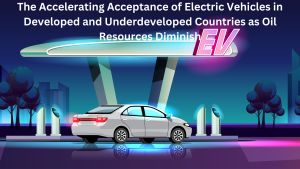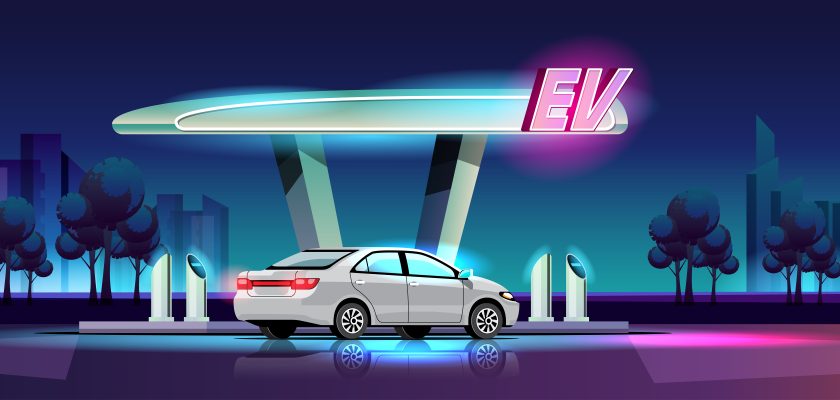
The depletion of oil reserves and the urgent need to address climate change have prompted the global transition towards sustainable transportation. Electric vehicles (EVs) have emerged as a promising alternative, offering numerous benefits such as reduced greenhouse gas emissions, improved air quality, and energy independence. As the world grapples with the impending disappearance of oil, both developed and underdeveloped countries are increasingly embracing EVs as a viable solution for the future of transportation.
1:Environmental Considerations:
a. Developed Countries: In developed nations, heightened awareness of climate change and environmental degradation has driven a significant shift toward greener technologies. The reduction of carbon emissions is a top priority, and electric vehicles provide a compelling solution. Governments have implemented policies such as tax incentives, grants, and subsidies to accelerate the adoption of EVs. Furthermore, strict emission standards and the establishment of charging infrastructure have created a favorable environment for the acceptance of EVs.
b. Underdeveloped Countries: Underdeveloped countries, despite facing economic challenges, are recognizing the importance of sustainable development. Many of these nations are heavily reliant on oil imports, which burden their economies and contribute to environmental degradation. Transitioning to EVs allows these countries to reduce dependence on costly oil imports and diversify their energy sources. Furthermore, improving air quality and reducing pollution-related health issues are additional driving factors. International collaborations and financial aid programs have enabled underdeveloped countries to invest in electric vehicle technology and establish charging infrastructure.
2:Technological Advancements:
a. Developed Countries: Advanced economies with strong research and development capabilities have been at the forefront of EV technology. Innovations in battery technology, increased driving range, and improved charging infrastructure have addressed the initial concerns regarding EV adoption. Additionally, the integration of renewable energy sources into the power grid enables cleaner energy generation and promotes the use of EVs.
b. Underdeveloped Countries: Underdeveloped nations, while initially lagging behind in EV technology, have witnessed significant progress in recent years. Collaborative initiatives and partnerships with developed countries and international organizations have facilitated technology transfers and knowledge sharing. This has allowed underdeveloped countries to leapfrog conventional automotive technologies and adopt EVs directly, capitalizing on the latest advancements.
3:Economic Factors:
a. Developed Countries: The economic benefits associated with EVs have garnered attention in developed nations. Electric vehicles offer long-term cost savings through reduced fuel and maintenance expenses, as well as potential job creation in the renewable energy sector. Additionally, the establishment of domestic EV manufacturing industries presents opportunities for economic growth and competitiveness in the global market.
b. Underdeveloped Countries: For underdeveloped countries, the adoption of EVs presents a unique opportunity for economic development. The establishment of local EV production facilities can create jobs and stimulate economic growth. Furthermore, the reduced reliance on imported oil can alleviate the financial burden associated with oil price fluctuations, improving the overall economic stability of these nations.
4:Infrastructure Development:
a. Developed Countries: Developed countries have made significant investments in charging infrastructure, ensuring convenience and accessibility for EV owners. Public charging stations, along with incentives for home charging installations, have addressed range anxiety concerns and increased consumer confidence. Furthermore, smart grid technologies enable efficient integration of EVs into the power system, ensuring optimal utilization of renewable energy sources.
b. Underdeveloped Countries: Underdeveloped countries, although faced with infrastructure challenges, have embarked on ambitious plans to establish charging networks. Strategic placement of charging stations in urban areas and along major highways is key to encouraging EV adoption. Innovative solutions such as mobile charging stations, battery swapping, and community charging initiatives are being implemented to overcome infrastructure limitations and improve accessibility.
Conclusion:
As the world transitions away from oil-based transportation, both developed and underdeveloped countries are increasingly embracing electric vehicles as a sustainable and economically viable solution. Environmental considerations, technological advancements, economic benefits, and infrastructure development are driving the acceptance of EVs across the globe. Collaborative efforts, international partnerships, and government support play crucial roles in facilitating this transition. By embracing electric vehicles, countries can pave the way for a cleaner and more sustainable future, reducing their carbon footprint and ensuring a greener planet for generations to come.

